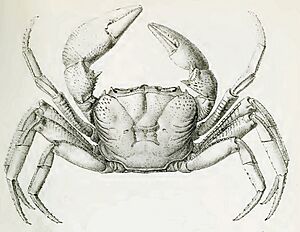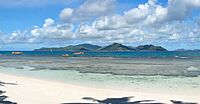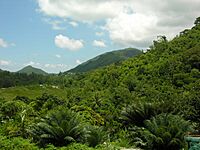Seychellum facts for kids
Quick facts for kids Seychellum alluaudi |
|
|---|---|
 |
|
| Drawing of dorsal view of Seychellum alluaudi | |
| Conservation status | |
| Scientific classification | |
| Synonyms | |
|
The Seychellum alluaudi is a special kind of freshwater crab. It lives only in the Seychelles islands. It is the only true freshwater crab found there. These crabs live in streams within the rainforests on the Seychelles' high, rocky islands.
Even though there might be many of them, we don't know a lot about how they live. If their homes (the streams and rainforests) become less healthy, S. alluaudi could become endangered. For now, it is listed as Vulnerable on the IUCN Red List. This means it needs protection.
S. alluaudi was first described in 1893. Back then, scientists thought it belonged to a different group of crabs called Deckenia. Later, they realized it was unique and gave it its own group, called Seychellum. Its closest relatives are two Deckenia species, which live in East Africa. Scientists have different ideas about how Seychellum ended up so far away on the Seychelles islands. The most likely idea is that it traveled across the ocean.
Adult Seychellum alluaudi crabs are dark yellow to brown. Their main body shell, called a carapace, is almost square. It is about 50 millimeters (2 inches) wide. Their claws are not the same size. Seychellum crabs are different from Deckenia crabs in many ways. For example, their legs and antennae are different lengths. Also, Deckenia crabs have flat legs, but Seychellum crabs have normal-shaped legs.
Contents
What Seychellum alluaudi Looks Like
Seychellum alluaudi is the only crab in the Seychelles that lives only in fresh water. Other crabs on the islands have babies that grow in the ocean. Freshwater crabs often lay large eggs, and Seychellum is no different. Its eggs are about 3.5 millimeters (0.14 inches) wide. One scientist, Rathbun, said they were "very large."
Adult crabs have a carapace (their main body shell) that is between 30 and 52 millimeters (1.2 to 2 inches) wide. The carapace is almost square and quite flat. This is different from its closest relatives, the Deckenia crabs, which have rounder shells. The surface of the Seychellum crab's shell is rough. It has small bumps, called tubercles, and lines that divide it into different areas. A raised line runs across the front of the shell. It is broken by a groove in the middle and on each side. The crab's color is dark yellow, which turns brown towards the front of its shell.
The crab's antennae are very small. Its claws are not the same size; one is bigger than the other. Deckenia crabs have flat walking legs, but Seychellum crabs have normal-shaped legs. Because of these differences, scientists can easily tell Seychellum alluaudi apart from Deckenia crabs.
How Seychellum alluaudi Got Its Name
Seychellum alluaudi was first described in 1893 by two scientists, Alphonse Milne-Edwards and Eugène Louis Bouvier. They named it D. alluaudi after Charles A. Alluaud, who collected the crabs they studied. A year later, in 1894, another scientist named Mary J. Rathbun described the same crab, but she called it "Deckenia cristata." She didn't know it had already been described.
At that time, there was only one other Deckenia species, D. imitatrix, which lived in East Africa. Later, another species, D. mitis, was found in East Africa in 1898. Rathbun herself realized in 1906 that "D. cristata" and "D. alluaudi" were the same crab. So, "D. cristata" became a synonym (another name) for D. alluaudi.
In 1995, a group of scientists including Peter K. L. Ng, Zdravko Števčić, and Gerhard Pretzmann studied the Deckenia family again. They decided that "D. alluaudi" was so different from the other Deckenia species that it needed its own group. They created a new group called Seychellum, and the crab got its current name: Seychellum alluaudi.
Where Seychellum alluaudi Lives and How It Got There
Seychellum alluaudi is found only on the high, rocky islands of the Seychelles. These islands are in the western Indian Ocean. You can find this crab on the four biggest rocky islands: Mahé, La Digue, Silhouette, and Praslin. It lives in mountain streams that flow through rainforest.
The closest relatives of Seychellum are the two Deckenia species that live on the African mainland.
It's a bit of a mystery how a crab that lives only in fresh water ended up on the Seychelles islands. Scientists have come up with a few ideas:
- Land Bridges: One idea from 1902 suggested that land used to connect the Seychelles to other big land masses.
- Continental Drift: Another idea is that the ancestors of Deckenia and Seychellum lived on one big landmass. This landmass then slowly broke apart due to continental drift. The Seychelles separated from what is now India a very long time ago. This idea is supported by the fact that other freshwater crabs are not found on nearby islands like Mauritius and Réunion, which are younger.
- Rafting: The most likely idea is that the ancestors of Seychellum traveled across the western Indian Ocean by "rafting." This means they might have floated on natural rafts of plants or debris. This could have happened when sea levels were lower, making the Seychelles Bank (the underwater area around the islands) much larger. This larger area might also explain how the crab is now found on four different islands. Scientists think Seychellum might be able to handle some salt water better than other freshwater crabs. This ability could have helped it survive the journey across the ocean.
Most recent research supports the idea of traveling across the ocean, but scientists are still studying this mystery.
Protecting Seychellum alluaudi
The International Union for Conservation of Nature (IUCN) checks how safe different species are. For Seychellum alluaudi, it's hard to use most of their rules because we don't have enough information about the crab.
However, based on its geographic range (where it lives), the crab would be considered Endangered if its habitat became unhealthy. Luckily, it is found in many places and lives in a protected area. Because of this, it is currently listed as Vulnerable. This means it's at risk, but not in immediate danger of disappearing.




